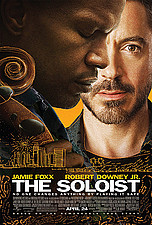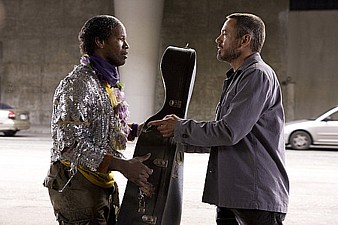
Joe Wright's film takes the complicated route and confuses the audience in the process
Too Many Notes:
The Soloist
4-24-09 "Knight Thoughts" web exclusive
By Richard Knight, Jr.
The Soloist
4-24-09 "Knight Thoughts" web exclusive
By Richard Knight, Jr.
Joe Wright, director of the emotionally compelling romantic costume dramas Pride & Prejudice and Atonement now returns with The
Soloist, a message picture that isn’t quite sure what kind of message it wants to impart to its audience. Based on a book by Los
Angeles Times columnist Steve Lopez (played in the film by Robert Downey, Jr. with tart toughness and a touch of heart), the picture
follows the events that occurred when Lopez happened upon Nathaniel Ayers (Jaime Foxx, in Dustin Hoffman/Rain Man mode), a
homeless musician with a rare gift. Nathaniel, who dresses in bright mustard colored hoodies and shirts, a purple flowered lei and
lots of sparkly vests, plays a two stringed violin with such eerie beauty that Lopez is swept away. Trying to engage Nathaniel in
conversation is tough going (it appears that he suffers from some form of mental illness) but eventually Steve learns that
Nathaniel's true instrument is the cello.
An initial column touches a retired cellist, who donates her instrument for Nathaniel to play. But Steve knows by now that the
valuable cello will be immediately stolen if left on the streets with Nathaniel, so he arranges for it to be kept at a nearby homeless
community shelter. Finding Nathaniel in an underground throughway, his favorite spot outdoors Steve allows him to play the
instrument before taking it to the shelter. Wright has the difficult job of imparting the tremendous impact of music upon the senses
– how to show something so subliminal? (A similar problem faced director Tom Tykwer in Perfume: The Story of a Murderer in which he
had to visually show the impact of smell upon the senses). Wright solves the problem beautifully: as Nathaniel plays a cluster of
pigeons soar high above Los Angeles, bobbing on the wind along with the gorgeous music and circling around the famed Gehry
designed Disney concert hall. This rapturous sequence is the emotional peak of the picture but later when Wright tires to repeat the
sensation, this time with a collage of colors, it doesn’t have the same success (and the collage, which recalls a muted version of
Kubrick’s trippy 2001: A Space Odyssey time travel visuals, goes on too long).
By that point Wright has taken the film down a myriad of not clearly defined paths: now that he’s become part of the story will Steve
assume full responsibility for helping Nathaniel rise beyond the streets? Or will he fall down on the job in the responsibility area once
again, as the script and his ex-wife/editor (played by Catherine Keener) keep not too subtly hinting at? Can Steve, with his powerful
column, affect anything more than a cosmetic change to the homeless problem? Is his refusal to change his slow approach in
gathering Nathaniel’s story and his stubborn refusal to drop it meant to be an indictment of business once again trumping art?
As Steve wrestles with the story and what’s best for Nathaniel – should he “allow” him to stay on the streets as he seems to want to
or should he force him to accept the nice apartment he’s used his influence to get him, should he encourage Nathaniel to continue
the lessons with the Bible thumping cellist teacher – the movie forgets to follow through on exactly what put Nathaniel on the streets
in the first place. When Nathaniel’s sister (Marcia Gay Hamilton) comes for a tentative visit we are cued to see this as a momentous
event in the lives of both but the story of what happened between the two, the intervening years, has been dropped out of the
picture. Wright also stubbornly resists the urge to tie things up in a neat bow even though the first half of the movie conditions us to
end up watching a triumphant Nathaniel taking his place onstage with the symphony orchestra while Downey and Kenner beam like
proud parents.
But this doesn’t happen and none of the many strands of Susannah Grant’s script are settled – Nathaniel’s preference for the streets
so at odd with society’s conditioning, Steve’s mostly unexplained personal conflicts, the complicated friendship of the two, the best
way to tackle the ongoing plight of the homeless, whether the newspaper business will be able to continue to afford writers the time
and effort to develop stories like Nathaniel’s, etc. And though this is all apparently true to life there are so many strands here I’m
not sure what we’re meant to take away from The Soloist. We’re not in save a soul territory for long – once redeemed, the redeemer
and his subject must figure out their responsibility to each other. Wright deserves points for making the attempt to tell the story
with these complicated issues intact but in doing so he deprives the audience of the “feel good” picture we’ve been primed for. This
is the rare movie where simplicity would have helped rather than hindered.
Soloist, a message picture that isn’t quite sure what kind of message it wants to impart to its audience. Based on a book by Los
Angeles Times columnist Steve Lopez (played in the film by Robert Downey, Jr. with tart toughness and a touch of heart), the picture
follows the events that occurred when Lopez happened upon Nathaniel Ayers (Jaime Foxx, in Dustin Hoffman/Rain Man mode), a
homeless musician with a rare gift. Nathaniel, who dresses in bright mustard colored hoodies and shirts, a purple flowered lei and
lots of sparkly vests, plays a two stringed violin with such eerie beauty that Lopez is swept away. Trying to engage Nathaniel in
conversation is tough going (it appears that he suffers from some form of mental illness) but eventually Steve learns that
Nathaniel's true instrument is the cello.
An initial column touches a retired cellist, who donates her instrument for Nathaniel to play. But Steve knows by now that the
valuable cello will be immediately stolen if left on the streets with Nathaniel, so he arranges for it to be kept at a nearby homeless
community shelter. Finding Nathaniel in an underground throughway, his favorite spot outdoors Steve allows him to play the
instrument before taking it to the shelter. Wright has the difficult job of imparting the tremendous impact of music upon the senses
– how to show something so subliminal? (A similar problem faced director Tom Tykwer in Perfume: The Story of a Murderer in which he
had to visually show the impact of smell upon the senses). Wright solves the problem beautifully: as Nathaniel plays a cluster of
pigeons soar high above Los Angeles, bobbing on the wind along with the gorgeous music and circling around the famed Gehry
designed Disney concert hall. This rapturous sequence is the emotional peak of the picture but later when Wright tires to repeat the
sensation, this time with a collage of colors, it doesn’t have the same success (and the collage, which recalls a muted version of
Kubrick’s trippy 2001: A Space Odyssey time travel visuals, goes on too long).
By that point Wright has taken the film down a myriad of not clearly defined paths: now that he’s become part of the story will Steve
assume full responsibility for helping Nathaniel rise beyond the streets? Or will he fall down on the job in the responsibility area once
again, as the script and his ex-wife/editor (played by Catherine Keener) keep not too subtly hinting at? Can Steve, with his powerful
column, affect anything more than a cosmetic change to the homeless problem? Is his refusal to change his slow approach in
gathering Nathaniel’s story and his stubborn refusal to drop it meant to be an indictment of business once again trumping art?
As Steve wrestles with the story and what’s best for Nathaniel – should he “allow” him to stay on the streets as he seems to want to
or should he force him to accept the nice apartment he’s used his influence to get him, should he encourage Nathaniel to continue
the lessons with the Bible thumping cellist teacher – the movie forgets to follow through on exactly what put Nathaniel on the streets
in the first place. When Nathaniel’s sister (Marcia Gay Hamilton) comes for a tentative visit we are cued to see this as a momentous
event in the lives of both but the story of what happened between the two, the intervening years, has been dropped out of the
picture. Wright also stubbornly resists the urge to tie things up in a neat bow even though the first half of the movie conditions us to
end up watching a triumphant Nathaniel taking his place onstage with the symphony orchestra while Downey and Kenner beam like
proud parents.
But this doesn’t happen and none of the many strands of Susannah Grant’s script are settled – Nathaniel’s preference for the streets
so at odd with society’s conditioning, Steve’s mostly unexplained personal conflicts, the complicated friendship of the two, the best
way to tackle the ongoing plight of the homeless, whether the newspaper business will be able to continue to afford writers the time
and effort to develop stories like Nathaniel’s, etc. And though this is all apparently true to life there are so many strands here I’m
not sure what we’re meant to take away from The Soloist. We’re not in save a soul territory for long – once redeemed, the redeemer
and his subject must figure out their responsibility to each other. Wright deserves points for making the attempt to tell the story
with these complicated issues intact but in doing so he deprives the audience of the “feel good” picture we’ve been primed for. This
is the rare movie where simplicity would have helped rather than hindered.
"Knight Thoughts" - exclusive web content


